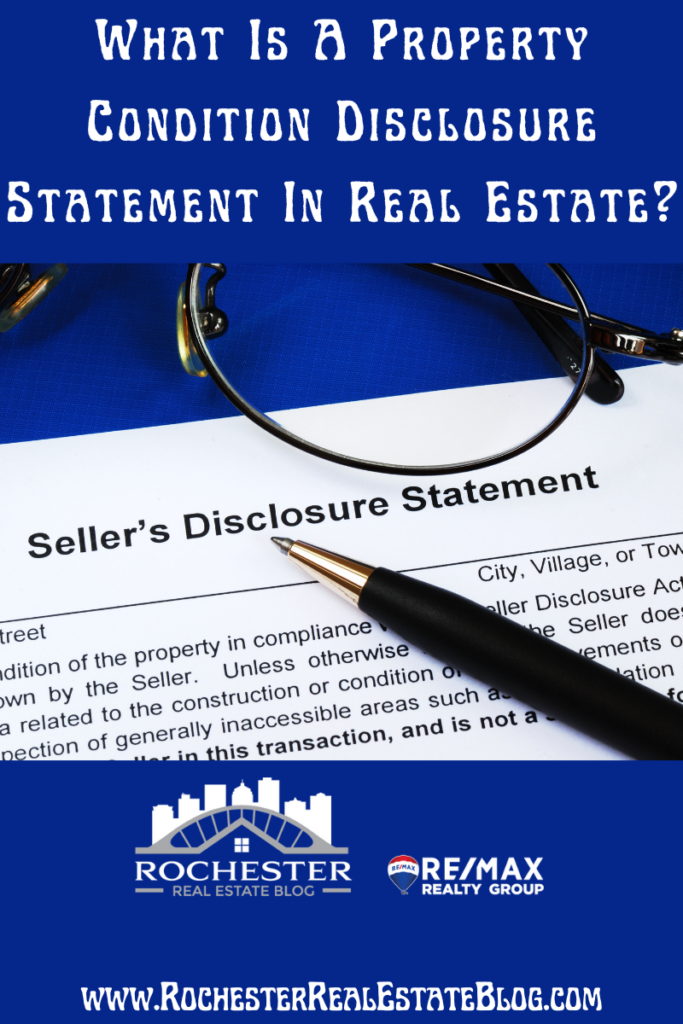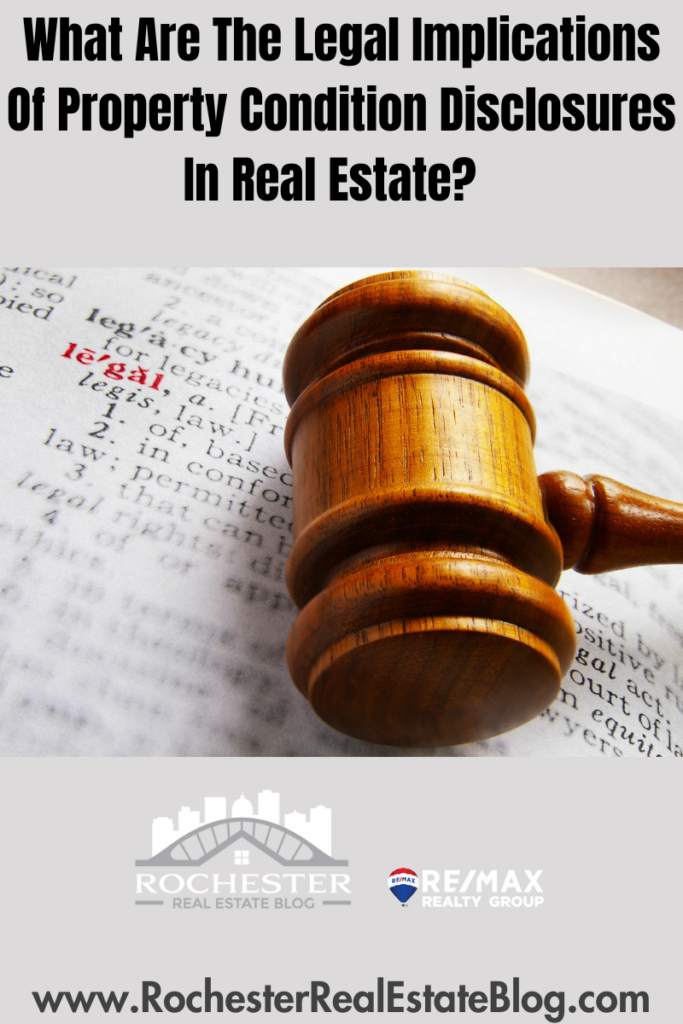Understanding the Importance of a Seller’s Property Condition Disclosure
Have questions about buying or selling a home?
Ask Now!
A seller’s property condition disclosure is a legal document required in some states in real estate transactions that provides undisclosed information about the property’s condition. It aims to inform buyers of any potentially unfavorable issues related to the property.
Disclosure requirements may vary by state and can include specific problem lists, questions for the seller, space for additional explanations, and a list of included appliances. Both buyers and sellers must understand the legal and financial implications of accurate disclosure.
In my experience as a Pittsford NY RE/MAX real estate agent, understanding a seller’s property disclosure is vital. Let’s explore some of the most crucial things to know.
What Is a Seller’s Disclosure?
A seller’s disclosure is a crucial component of real estate transactions that provides buyers with essential information about the property they are considering purchasing. A seller’s disclosure form requires homeowners to reveal any undisclosed information about the property’s condition that could be unfavorable for buyers.
Understanding the Purpose of a Seller’s Disclosure
The primary purpose of a seller’s disclosure is to ensure transparency and fairness in real estate deals. It aims to protect buyers from purchasing a property with undisclosed issues that could potentially impact its value or pose risks in terms of safety or maintenance.
By providing accurate and comprehensive information, sellers enable buyers to make informed decisions and negotiate terms that reflect the property’s actual condition.
Importance of Seller Disclosures in Real Estate Transactions
Seller disclosures play a significant role in real estate transactions. Buyers heavily rely on this information to assess the risks and potential problems associated with a property. It allows them to evaluate whether the property meets their requirements and expectations.
Additionally, seller disclosures can help establish trust between buyers and sellers, as the willingness to disclose information demonstrates the seller’s commitment to transparency.
Buyers must perform less real estate due diligence in areas where disclosures have been presented.
Overview of Disclosure Requirements in Different States
It is crucial to note that disclosure requirements may vary from state to state. Each state has specific laws and regulations dictating the extent of information that sellers must disclose to buyers. Some states have more detailed and specific disclosure forms, while others have broader requirements.
Buyers and sellers should consult the regulations in their particular state to ensure compliance with the disclosure obligations.
Essential Information in a Seller’s Property Condition Disclosure
Detailed Description of the Property’s Condition
When it comes to a seller’s property condition disclosure, providing a detailed description of the property’s condition is essential. This section should include information about the property’s age, size, and general shape, including its exterior and interior features. It should cover the roof, foundation, plumbing, electrical systems, HVAC, and recent renovations or upgrades.
Details about potential issues, such as water damage, structural problems, or pest infestations, should also be included.
Disclosed Issues and Problems
In this section, the seller should disclose any known issues or problems with the property. These can range from minor cosmetic concerns to significant structural defects.
In states where disclosure is required, sellers must be honest and transparent about any issues that may affect the value or usability of the property.
Common problems to disclose may include leaks, mold, faulty wiring, plumbing issues, or previous flooding. Providing accurate and detailed information is essential to help potential buyers make informed decisions.
Disclosure of Repairs and Maintenance History
Buyers are often interested in the repairs and maintenance history of a property. This section should outline any significant repairs or renovations performed on the property, including dates and descriptions of the work done. It should also mention regular maintenance activities like HVAC servicing, roof inspections, or pest control treatments.
Providing a comprehensive repair and maintenance history helps buyers assess the overall condition and upkeep of the property.
Sellers can ensure transparency and trust with potential buyers by describing the property’s condition, disclosing known issues and problems, and providing a thorough repair and maintenance history.
Understanding the Legal Implications of Seller Disclosures

When it comes to seller disclosures in real estate transactions, there are legal obligations that sellers must adhere to. Understanding these obligations is crucial to ensure a smooth and legally compliant process.
This section explores the critical aspects of legal implications surrounding seller disclosures, including the obligations of sellers to disclose accurate information, potential consequences for failure to provide proper disclosures, and the rights and recourse available to buyers in case of inaccurate seller disclosures.
Legal Obligations for Sellers to Disclose Information
Sellers have a legal duty to disclose any relevant information about the property that may influence a buyer’s decision. The scope of what needs to be informed varies by state. Still, it generally includes material defects, past repairs or renovations, known hazards, and any other information that may affect the value or desirability of the property.
This obligation extends to both physical aspects of the property and non-physical elements that may impact its use or enjoyment.
Sellers should provide a comprehensive and truthful disclosure of all known facts, ensuring that the buyer understands the property’s condition before making an informed decision.
Consequences for Sellers’ Failure to Provide Accurate Disclosures
If sellers fail to provide accurate and complete disclosures, they may face legal consequences. Buyers can hold sellers accountable for financial losses from undisclosed defects or issues.
Sellers may be subject to lawsuits, financial damages, and even cancellation of the sale. Additionally, failing to disclose information can harm the seller’s reputation and credibility in the real estate market.
Sellers must understand that intentionally withholding or misrepresenting information can have severe legal ramifications. Honesty and transparency in the disclosure process fulfill legal obligations and foster trust and goodwill between the parties involved.
The Buyer’s Rights and Recourse in Case of Inaccurate Seller Disclosures
Buyers have rights and recourse if they discover inaccurate or incomplete seller disclosures. In such situations, buyers may have legal grounds to pursue remedies, such as rescinding the contract, seeking repairs or compensation, or renegotiating the terms of the sale.
It’s advisable for buyers to carefully review the seller’s disclosures, conduct independent inspections or assessments, and consult with legal professionals to understand their rights and options.
In case of discrepancies between the disclosed information and the actual property condition, buyers should take appropriate action to safeguard their interests and protect their investments.
Understanding the legal implications of seller disclosures is crucial for buyers and sellers in real estate transactions. Sellers must fulfill their legal obligations by providing accurate and comprehensive disclosures.
At the same time, buyers should exercise due diligence to understand the property’s condition before finalizing the purchase.
Specific Disclosure Requirements for Buyers
When purchasing a property, buyers have specific responsibilities in reviewing seller disclosures to ensure they make an informed decision.
Here are vital considerations regarding buyers’ disclosure requirements:
Buyers’ Responsibilities in Reviewing Seller Disclosures
Buyers should thoroughly review all seller disclosures provided to understand the property’s condition and any potential issues. Buyers must allocate sufficient time to read and comprehend the disclosed information carefully.
Buyers must take their responsibilities seriously and not overlook any disclosed problems or defects that may affect the property’s value or their decision to purchase.
Importance of Property Inspections and Due Diligence
Though sellers must disclose known issues, buyers should conduct property inspections and due diligence to uncover hidden problems.
Hiring a licensed inspector to evaluate the property thoroughly is highly recommended. Inspections can identify issues the seller may not have disclosed or were unaware of, allowing buyers to make informed decisions and potentially negotiate repairs or adjustments to the purchase price.
How to Utilize Seller Disclosures in Negotiations and Purchase Offers
Buyers can use seller disclosures during negotiations and while preparing purchase offers. By closely analyzing the disclosed issues, buyers can address them in their recommendations and negotiate for repairs or adjustments to the price.
Carefully reviewing the disclosures provides buyers with valuable information to make informed decisions about how to proceed with their purchase.
By adhering to buyers’ responsibilities in reviewing seller disclosures, conducting thorough property inspections, and utilizing the disclosed information during negotiations, buyers can make more informed decisions when purchasing a property.
Common Issues and Pitfalls with Seller Disclosures

When it comes to seller disclosures in real estate transactions, there are several common issues and pitfalls that both buyers and sellers should be aware of. Understanding these challenges can help ensure a smoother and more transparent transaction.
Let’s explore some of the key concerns:
Challenges in Identifying and Disclosing Property Defects
One of the primary challenges with seller disclosures is identifying and disclosing property defects. Sellers may unintentionally overlook or fail to recognize specific weaknesses, especially if they have lived in the property for a long time. This can lead to incomplete or inaccurate disclosures, potentially disadvantaging the buyer.
To address this challenge, sellers should thoroughly inspect their property and comprehensively list known defects or issues. It is crucial to be diligent and honest when completing the disclosure form to provide buyers with a clear understanding of the property’s condition.
Handling Disputes and Resolving Conflicts Over Disclosures
Disputes and conflicts may arise between buyers and sellers regarding the accuracy or completeness of seller disclosures. In some cases, buyers may discover undisclosed issues after purchasing the property, leading to disputes and potential legal actions. These conflicts can be time-consuming, stressful, and costly for both parties.
To minimize the risk of disputes, sellers should be transparent and provide all relevant information about the property. Buyers should carefully review the disclosed information and consider conducting their inspections to ensure the accuracy of the disclosures. In case of any conflicts, seeking legal advice to resolve the issues fairly and promptly is advisable.
Ensuring Accurate and Comprehensive Seller Disclosures
Ensuring accurate and comprehensive seller disclosures is crucial for maintaining a fair real estate transaction. Sellers must take their disclosure obligations seriously and provide all relevant details about the property’s condition to potential buyers. Failing to do so can have legal ramifications and jeopardize the trust between the parties involved.
To ensure accuracy, sellers should gather all pertinent documents, such as maintenance records and repair receipts, and include them in their disclosures. Addressing evident and hidden issues that could impact the property’s value or pose risks to the buyers is essential.
Comprehensive seller disclosures not only protect the buyers but also protect the sellers from potential lawsuits or disputes in the future. By being thorough and transparent, sellers can promote trust and confidence in their property, fostering a smoother transaction for all parties.
Final Thoughts on Seller Property Condition Disclosures
In conclusion, seller property condition disclosures are vital to real estate transactions. It ensures transparency, protects the buyer’s interests, and protects sellers from legal consequences. Both parties should prioritize thorough and accurate disclosures to maintain a fair and successful real estate transaction.
About the author: The above “Understanding the Importance of a Seller’s Property Condition Disclosure” was written by Kyle Hiscock. Kyle has been selling real estate in the Greater Rochester NY area for over 12 years and has helped hundreds of buyers and sellers move in, move around, and move out of the area!
About Rochester’s Real Estate Blog: Rochester’s Real Estate Blog is owned and operated by Kyle Hiscock of the Hiscock Sold Team at RE/MAX Realty Group.
Since being launched in 2013, Kyle has published more than 150 quality, in-depth, and unique real estate related articles on the Rochester Real Estate Blog pertaining to topics varying from home selling to mortgages and everything in between! In addition to quality real estate related content, there are also many quality articles pertaining to the Greater Rochester NY area.
The Rochester Real Estate Blog has been recognized by many reputable websites as one of the best real estate blogs to visit and follow! In addition to being recognized as one of the best real estate blogs, Kyle has been recognized as one of the top Realtors on social media by several organizations and websites.
The Hiscock Sold Team has almost 50 years of combined experience, so if you’re thinking of selling or buying, we’d love to share our knowledge and expertise.
We service the following Greater Rochester NY areas: Irondequoit, Webster, Penfield, Pittsford, Fairport, Brighton, Greece, Gates, Hilton, Brockport, Mendon, Henrietta, Perinton, Churchville, Scottsville, East Rochester, Rush, Honeoye Falls, Chili, and Victor NY.